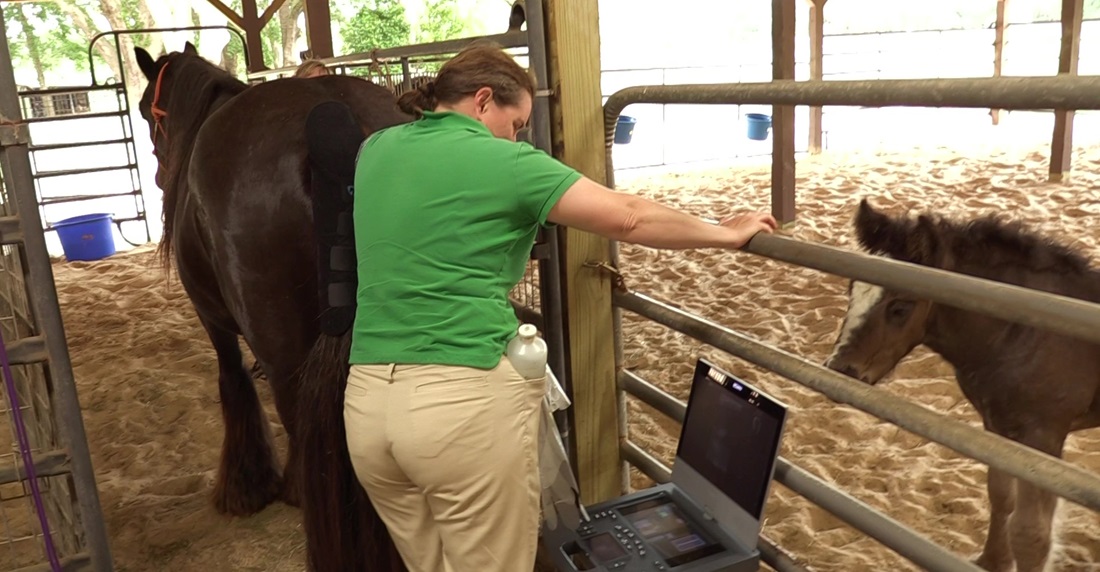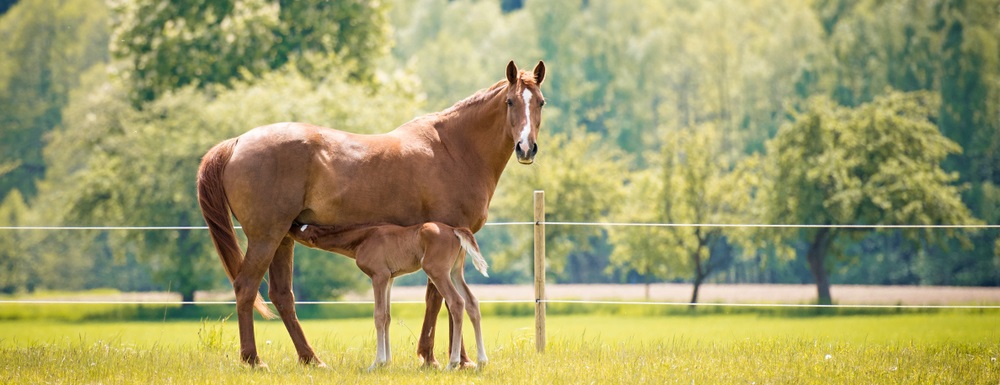Whinny’s Wisdoms

Spring is in the air, the birds and the bees are out, and foals are hitting the ground. Everyone seems to be thinking about making more of them! Don’t we have enough horses in the world? I think we need more mice. But seriously, breeding your horse is a significant decision that requires careful consideration. In the United States, we’re facing an overpopulation of horses, and adding more to the population should be a thoughtful choice. While the idea of passing down desirable traits, like behavior, movement, personality, or talent, can be appealing, it’s crucial to know that these traits aren’t always inherited by offspring. Each horse is unique, and what makes a great performer or companion doesn’t always transfer to the next generation.
Moreover, breeding a mare especially demands foresight and planning for the foal’s future. It’s essential to have a well-thought-out plan for the foal once it arrives, including a budget set aside for potential health issues in its early days to weeks of life. Consider that if a foal can’t be sold due to genetic issues or a lack of desired talents, the responsibility for its care falls on the mare owner for the rest of its life. This responsibility extends far beyond the cute foal stage into adulthood, which involves time, finances, and dedication. Making the decision to breed should involve serious consideration of the long-term commitment to the foal’s well-being, ensuring a stable and secure future for both the mare and her offspring. And if you’re looking to make a profit from breeding horses, just cut your losses now! I can’t even tell you how many financial horror stories I’ve overheard at the clinic from owners losing money on breeding.
Whinny’s Wisdom: MOST people who breed horses do not turn a profit from it. Don’t count on ANY foal to be a financial windfall!
Understanding Mare Reproductive Health
Reproductive services for mares should involve comprehensive examinations, utilizing diagnostic tools like ultrasound and hormonal assays, and scheduled follow up exams. This helps identify any potential issues that could hinder fertility, such as uterine infections, hormonal imbalances, or structural abnormalities.
Various health problems, from infections to systemic conditions, can affect a mare’s fertility. Addressing these concerns early is crucial. Treatment options may include antibiotics, hormonal therapies, or management adjustments to enhance overall reproductive success. It’s also very important to consider if it is worth pursuing breeding in a mare with any of these reproductive conditions. Basically, do you want to breed A horse, or do you want to breed THIS horse?

Pre-Breeding
It pays to be prepared! Before any birds or bees are brought together, there are some important steps. First of all, is your mare fit and healthy enough to be bred? Let’s go over what information we need to figure that out:
Vaccination Status: All horses should be vaccinated regularly by the veterinarian you have a great relationship with, but it’s even more important for a broodmare whose immune system will be challenged by growing a brand-new creature for 11 months. Our docs require mares to be up-to-date on vaccinations for diseases like Eastern and Western Encephalitis, Tetanus, West Nile, Equine Influenza, Equine Herpes, and Rabies. Go check out some of Tony’s old blogs to learn about these vaccines if you’re curious!
Dental and Hoof Health: Regular farrier visits and dental care are vital for maintaining a mare’s health during pregnancy. Would you want to carry an extra 100 lbs in your abdomen if you already had bad feet or a toothache?
Reproductive History: Knowing if your mare has previously foaled or been bred helps us understand potential complications or issues that might arise during the breeding process. Any previous reproductive diagnoses, such as uterine infections or cysts, are critical to know about and potentially manage prior to insemination. A mare that has had a difficult pregnancy previously won’t necessarily repeat that, but she may. Similarly, a mare that’s had very easy pregnancies in her past could always have a difficult time this go around. It’s important to be emotionally and financially prepared for above-and-beyond care if your mare has a difficult pregnancy. This can involve frequent exams, medications, or even hospitalizations. If your horse has not ever been pregnant before, this can also sometimes present challenges, especially if she is older than 8-10 years of age.
The prebreeding reproductive evaluation is a pivotal step in ensuring a successful breeding outcome. Through the use of diagnostic tools like ultrasound, uterine culture, and cytology, our doctors comprehensively assess the mare’s reproductive health. Ultrasound examinations offer valuable insights into the reproductive tract, detecting structural abnormalities, cysts, or inflammatory changes that might hinder fertility. Uterine cultures identify bacterial infections within the uterus, enabling targeted antibiotic treatments to resolve underlying issues. Concurrently, uterine cytology evaluates the cellular composition of the uterine lining, pinpointing inflammation or irregularities that could affect the mare’s ability to conceive or carry a pregnancy to term. This comprehensive evaluation empowers veterinarians to proactively address potential issues, optimizing the mare’s reproductive health and significantly increasing the chances of a successful breeding experience.
Turn the Lights On
For early breeding (before March/April), implementing a Light Protocol helps regulate the mare’s estrous cycle. This involves simulating longer daylight hours to prompt hormonal changes, preparing the mare’s reproductive system for an earlier breeding season. This process typically begins around 60-90 days before the desired start of the breeding season, usually in late fall or early winter.
How to Implement a Light Protocol:
- 1. Light Duration and Intensity: Mares are sensitive to light changes. Mimicking longer daylight hours tricks their bodies into believing spring is approaching, stimulating hormonal changes. Provide artificial lighting in the mare’s stall, ensuring 16 hours of continuous light daily. Natural and artificial light combined should meet this duration.
- Light Timing: Start the Light Protocol in late fall or early winter. Calculate backward from the desired breeding date, allowing 60-90 days of light stimulation before the intended breeding season begins.
- Light Management: Ensure consistent lighting without interruption. Use 100-200-watt LED, incandescent or fluorescent bulbs placed approximately eight feet above the mare. The lighting should be evenly distributed throughout the barn, including the stall where the mare resides.
- Light Control: Use automatic timers to maintain a regular schedule. Artificial light should start early in the morning, simulating dawn, and continue until late in the evening, mimicking dusk. Avoid sudden changes in light intensity or duration.
Implementing the Light Protocol at the right time is critical. For early breeding, starting the protocol around late November to early December allows for the required 60-90 days of light exposure before the breeding season, typically beginning in February or March. Regular monitoring during the Light Protocol ensures proper response. Veterinary guidance and monitoring hormone levels may be necessary to confirm the mare’s readiness for breeding after the completion of the light exposure period.
Timing
As they say, timing is everything. Once our team has determined your favorite mare is all ready for a bun in the oven, the work has only just begun. Horses have a 21-day estrous cycle, but the period of fertility (estrus) varies from 2-8 days across each cycle, with the length of diestrus (uterine inactivity) adjusting to keep the cycle at about 21 days. Because of this variability, it is crucial your mare have ultrasound assisted reproductive exams OFTEN. When I say often, I mean sometimes multiple times per day. The margin for error in timing depends on how you are planning to have your mare bred.
In general, we have the most flexibility if the mare will be live covered and the least flexibility if she will be artificially inseminated using frozen semen. This usually means you are either boarding your mare at our clinic (yay, more friends for me!) or trailering her in every 1-3 days until she is bred. After the deed is done, we have to confirm she has done her part and released an egg. This is also done with ultrasound. Then, there’s more to schedule!

Fourteen days after confirmed ovulation will be the first pregnancy check. That 14-day mark is super important, because we have to look for twins. Horses are super particular with their insides (see all of our colic blogs!) and their insides can absolutely not handle two babies at once. So, if we find twins, we have to “pinch” one of the embryos in order to save the other embryo and the mother. But we can only do this very early in her pregnancy.
After that fourteen-day check when she is confirmed pregnant, one of the nice technicians at the clinic will email you a Pregnant Mare Schedule which details the next 11 months of her and your life. She’ll be visiting us at least every few months for ultrasound exams and vaccines until her baby is born. And if you feel anything is going wrong in between those frequent visits, she will visit us then too!
Conclusion: Breed Responsibly
While the thrill of breeding your mare is enticing, responsible breeding involves thorough consideration and preparation. Each mare is unique, and individualized care to whole horse health is vital for successful reproduction. At Springhill Equine, our docs prioritize individualized care and thorough assessment to maximize the chances of a successful breeding outcome. Our aim is not just conception but ensuring the health and well-being of both mare and foal.
I think I gave a pretty thorough lecture today, but if you would like any further information or to schedule your mare’s reproductive evaluation, you can speak to our lovely office staff by calling 352-472-1620.
Until next week,
~Whinny
P.S. If you really want to get intense with breeding knowledge, my docs have several seminars on the topic over on our YouTube Channel. They are way more in-depth than my blog, and completely free! You can find all of our Seminars by Clicking Here.
 Whinny’s Wisdoms is the official blog of Whinny the Clinic Mouse at Springhill Equine Veterinary Clinic in Newberry, Florida. If you liked this blog, please subscribe below, and share it with your friends on social media! For more information, please call us at (352) 472-1620, visit our website at SpringhillEquine.com, or follow us on Facebook!
Whinny’s Wisdoms is the official blog of Whinny the Clinic Mouse at Springhill Equine Veterinary Clinic in Newberry, Florida. If you liked this blog, please subscribe below, and share it with your friends on social media! For more information, please call us at (352) 472-1620, visit our website at SpringhillEquine.com, or follow us on Facebook!
[jetpack_subscription_form title="Subscribe to Whinny's Wisdoms"]

